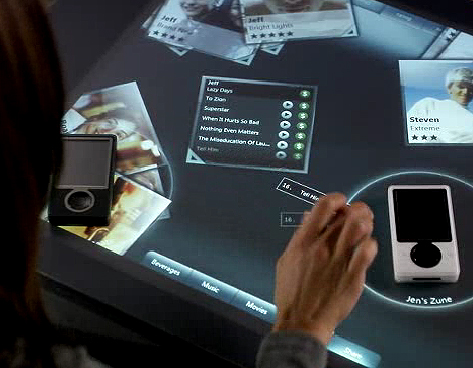The Consumer Electronics Show in 2011 confirmed the importance of touch for the next generation of devices.
Touch has been around, but it is multi-touch that has made a big difference. Just the simple pinch and expand motions have made the technology more closely resemble natural human interaction. Multi-touch opens up gestures.

Microsoft has most recently moved the game forward with Surface 2 introduced at CES 2011 this year. It was developed in a cooperative effort between Microsoft and Samsung. Samsung’s SUR 40 computer is the base for the new Surface. Samsung is able to deliver this computer at a (more) attractive price point of $7,600. The earlier Surface tabletop cost more than $12,000. In this newest version of Surface the companies have introduced PixelSense, which replaces the camera technology under the table with infrared sensors. As Microsoft says it, the new technology turns every pixel into a camera. It allows more than 50 simultaneous touch points on the table, it supports pen input, and it can “read” objects put on the table.The breakthroughs in this version of Surface, enable it to be thinner and lighter so it can be more easily mounted on a wall. The Surface computer is powered by an AMD Athlon II X2 2.9 GHz Dual-Core processor and Radeon HD 6700. Microsoft is ready with an SDK for eager developers. AMD is saying that their G-Series Fusion chip is perfect for an application like Surface because it provides graphics capabilities with low power and low cost.
Another breakthrough highlighted in the Microsoft Surface demonstration is already in use in a variety of applications and that’s Corning Gorilla Glass for touch LCDs. The Surface computer is using the largest piece of gorilla glass made so far. The exceedingly tough glass is bonded to the LCD and the touch elements enabling a brighter screen. Gorilla Glass is also used in the Samsung Galaxy, the Dell Adamo, and the iPhone (though as far as we know, Apple has not confirmed this). In fact, Corning says that over 280 devices from 80 manufacturers use Gorilla Glass. David Pogue in the New York Times says Corning made about $100 million from Gorilla Glass in 2009, they’ll make $250 million in 2010 and expect to break a billion in 2011.
Touch is an obvious plus for CAD applications and it’s a feature the industry has inched toward every 10 years or so from digitizers, to pen input, to the iPad. Designers start out their careers with pencil and paper and they never really put it down. However, the problem so far has been less than great response from older technologies, and not much in the way of standards either. The cycle has come around again and companies with the power to push through standards have leading technologies. Apple’s iPad has almost irresistible gravitational pull for the CAD vendors but it’s not so interested in pen input, at least not yet or not that they’ve told us. Microsoft, in its own characteristic way is going at the problem of input technologies with an elephant gun – they’ve got multi-touch, they’ve got pen, they’ve got a great big computer, they got eyeballs with Kinect – they figure they’re bound to hit something. And let’s not forget Android. The Google guys have a basic anything-Apple-can-do-we-can-do-for-free attitude. The app store approach lets developers experiment with touch applications and there is already quite a bit of software that can handle basic design drawing and conceptualization. Autodesk’s Sketchbook and AutoCAD WS products for the iPad are obvious examples. Some other tools worth looking at include Layers Pro by Ben Gotow, Adobe Ideas, and Brushes by Steve Sprang. A feature these products have in common is the portability of content created on the iPad. In the case of the art products like Layers and Brushes, drawings can be exported as Photoshop files with layers intact. It’s all a start, but it returns sketching, and free form thinking back to the hands of creative people, where it belongs.
Microsoft is taking the view that this shift is much futher down the road, and they’re introducing the technology as starter kits. For instance, when Microsoft demonstrates CAD-like applications, it’s as a kiosk application where people can try out paint colors.
It’s not a bad deal to have this combination of environments supporting touch development. Small developers can take risks by developing small, focused touch-based apps for mobile platforms. Meanwhile, Microsoft is hoping to build an ecosystem based on its Direct APIs.
What do we think?
What’s promising this time is that there are powerful companies headed in something like the same direction. It’s too bad that Microsoft doesn’t seem interested enough in pushing their technology to the mainstream faster. Or maybe we should say, Microsoft sometimes seems to have a strange idea of what the mainstream wants to do with their technology. There is a 2007 parody http://www.youtube.com/watch?v=CZrr7AZ9nCY of Surface that still applies. Its current videos show Surface applications at work in retail stores, bars, and doctors’ offices but Microsoft is obviously not seeing the technology for prime time situations yet. It’s too bad. One of the most compelling demonstrations of Surface was shown at SXSW as a video editor managed a time line, found assets, added sound, all by moving it around on the surface display. It was all very Minority Report.
The mobile market, meanwhile is hard at work translating everything we do into its component parts and turning them into apps. Somewhere along the way, tools will offered that combine ways to spontaneously input information in the best formats for that information – drawings will be drawn, words will be spoken, data will be entered, and gestures will be made. It is a revolution that’s more than a decade away, Microsoft is right on that point, but the race is already on.





